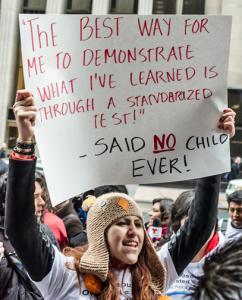Why We Choose to Leave MORE
By John Giambalvo and Mike Schirtzer
We became involved with teacher unionism after a few years of working in the schools as a result of our classroom and school-level experiences where we saw public school teachers and students being cheated out of the resources needed to provide them with an adequate education. Sparked by the general lack of response from our union, the United Federation of Teachers, our involvement led us to join the Movement of Rank and File Educators (MORE), an organization that we believed would respond to concerns of UFT members by allowing them, as well as members of their school community, a space to voice concerns about our schools within the political structures of our union and the Department of Education of the City of New York.
We joined MORE during a time when few voices within the UFT represented the needs and interests of our colleagues.
We joined under the premise that our union had the potential to be the most powerful vehicle of change for teachers, students and families in New York City and beyond.
We joined MORE to create a more assertive union, where member voice was the greatest priority and, when heard, would lead it to action for the entire education community.
We joined MORE to strengthen the UFT for the betterment of the teachers, students and families we serve. We were aware that the UFT apparatus, under the almost 60 year stewardship of the Unity Caucus, had developed more than a bit of sclerosis, had not been adequately serving the needs of its members, and that that power structure needed to be challenged from the ranks. We believed MORE offered the potential to engage in that challenge.
We joined MORE and were faced with working with people with many different political backgrounds and ideologies, including some differing from our views. We made concerted efforts to function collectively with other members of MORE to improve conditions in our schools. We learned the basics of their ideologies and did our best to find middle ground. We genuinely believed we were learning to struggle together in order to improve conditions, especially for those who were affected by hurtful policies on a daily basis.
We joined MORE to prioritize making connections with teachers throughout all five boroughs; to construct and devote our work towards an agenda that would have wide appeal to a majority of members of our union who have been shut out of influence. In order to be successful MORE would have to, not only offer a way forward by leading in a new direction, but do so by being responsive and interacting with UFT members in our own schools and beyond to transform a union that operated in an absolute top-down manner.
We have been disappointed.
Unfortunately, we’ve seen that MORE has been increasingly dominated by one group with a definite pre-formed unyielding ideology. We’ve come to understand over time that these voices do not represent the needs of most of our members, or even our students or parents. MORE has devolved into an organization that uses anti-democratic and secretive methods to push the agenda of this faction and marginalize, isolate and push vocal opponents out of the caucus.
There were many opportunities for the members of MORE to analyze the results of our work in order to determine the course of the group’s direction, but it has chosen not to do so. There were meetings with varying topics, causes endorsed, social media/blog data, and the results of the 2016 UFT election which provided data on voter turnout by division and district which clearly showed a much higher turnout in the Queens high schools (36.4% compared to 12.8% in the Bronx and 14.5 in Manhattan, boroughs where key leaders of the current leadership in MORE are based.)
Queens high school voter turnout was clearly the crucial difference in winning the high school seats but admitting that would be counter to the narrative being pushed.
This turnout was mainly due to the organizing efforts of two key MORE members. (Ed Note: Details and analysis of 2016 high school elections at
http://iceuftblog.blogspot.com/2016/07/district-by-district-breakdown-shows_3.html?m=1).
This should have been an important lesson for MORE about the kind of activism by some more members that reaches out and resonates with rank and file teachers. Yet, these people are the very people who are being pushed out of MORE. One of these people is the chapter leader of the largest high school in Queens with 300 UFT members and an elected UFT Executive Board member.
The other was a former chapter leader of a closed school who led a valiant battle to keep his school open but who was forced to become an ATR. One of the most respected voices in the UFT for almost 30 years who developed hundreds of contacts in schools all around the city, and served for a decade on the UFT Executive Board. He too is being forced out of MORE.
Along with one of us, two of the four MORE Executive Board elected high school representatives are being pushed out of MORE. What does this mean for MORE as an organization when it feels activists with this history and stature and the overwhelming support of their colleagues don’t belong?
Instead of revisiting different petitions we advocated for or addressing the way we have utilized our positions on the UFT Executive Board to create voice for colleagues, the small group taking control of MORE chose to purposely ignore these results, criticized us, and attempted to micro-manage us over issues like
class size and the defense of ATRS and rank and file UFT members over abusive principals because this work did not fit their preordained agendas.
Attempts to build a large, robust organization, including the creation of newsletters produced for wide distribution, planning meetings with topics related to school-based issues, like the nuts and bolts of enforcing the contract or running for chapter leader, and attempts to compete in union elections (both at the chapter level and for citywide officers), have been met with obstruction, in-fighting, frustrating layers of bureaucracy and the gradual disappearance of democratic decision making.
All this is a direct result of the group’s lack of democracy and failure to connect with members in our schools.
Predictably, instead of growing into a member driven movement, MORE has seen its numbers dwindle to levels rivaling our earliest beginnings in 2012. Instead of examining and discussing the reasons for the shrinking of MORE, such as the inability to develop a newsletter and distribution network or even a regular handout at the UFT Delegate Assembly, the constant excuse has been that all the problems in MORE have been due to some rude emails by a few people.
In fact, dozens of people have abandoned MORE over the years due to the rigid ideological framework imposed in MORE. Their “solution” to the crisis in MORE has been to actively move to push out even more members who do not go along with their line, many of them older and experienced in union politics, obviously a threat to their ability to win over new and inexperienced teachers who enter MORE to their ideological line. Rather than engage in discussion, including historical reference and analysis, they want to promote their own political positions, positions that are rarely open to debate.
It is especially difficult for us to remain with a group that no longer honors the principles of democracy. There was a glaring lack of due process involved in our recent suspension from the MORE listserves and the caucus’ steering committee, which just happened to remove our ability to vote on crucial decisions concerning the direction they wanted to steer MORE in. There is no provision in the by-laws from suspension from steering.
This decision began as a disagreement over political process and the tone of some emails. The suspensions were decided without either of us being present. Just four people out of nine on the committee created, ex-post facto, new rules. Since MORE is on record as opposing suspensions and calling for restorative justice for students, calls for the use of restorative justice practices in lieu of suspension in our case were voted down.
As union members, social justice activists, and New York City public school teachers, we cannot compromise the principle of due process. We must expect from ourselves the rights we demand for our co-workers and our students.
The loss of trust in the people who made these decisions will be difficult to repair. The realization that a caucus dedicated to the principles of social and restorative justice but can no longer muster enough respect for basic due process portends a future for the group that is far too troubling for us to be part of.
It is simply not acceptable to be involved with an organization that does not hold itself to the very values of democracy upon which it is premised and for which we have both worked.
There are many good people in and around MORE and we are proud of our past work with them. But too many priorities have changed over time, both for the group and for ourselves. We seek out the serious work of helping to build a more robust union, one that can affect policy as it improves the conditions under which we teach and our students learn. We have concluded MORE as a caucus is not capable or willing to build this movement. In order to work with rank and file UFT members and other stakeholders, we feel it’s better we separate ourselves now. We are leaving the organization and disassociate our names from it.
We still intend to spend time learning from our from past successes and failures in future endeavors we pursue.
There is a Janus decision on the horizon, a well financed effort by corporations and interest groups to undermine unions, and a relentless effort to privatize our schools by forcing out veteran UFT members and closing schools in our poorest neighborhoods, which harms our children of color and immigrant children. It is imperative that our union fights harder than ever against these forces.
We are dedicated to defending members unfairly under attack, ensuring our children are provided a great public education in well resourced schools, fighting for racial integration of schools, defending immigrant, African-American, Latino, Muslim, and LGBTQ union members and students. We will continue our work in our chapters, Delegate Assemblies and Executive Board meetings to educate and activate union members, defend public education, demand due process for our students and colleagues, and advance the cause of labor unions for all workers.
In Solidarity,
Mike Schirtzer: UFT Executive Board, UFT Delegate, Social Studies Teacher
John Giambalvo: Social Studies teacher, Coordinator of Student Activities
=======
John Giambalvo will is completing 18 years of service teaching social studies. He teaches in a Queens high school.
Mike Schirtzer, is a member of the UFT Executive Board and a delegate from his school. He has been teaching social studies at Leon Goldstein HS in Brooklyn for 11 years
*=========
District 71 Manhattan High Schools: 683 votes= 14.5% of total HS turnout
District 72 Bronx High Schools: 594 votes=12.6%
District 73 Brooklyn High Schools: 729 votes=15.5%
District 76 Brooklyn-Staten Island High Schools: 984 votes=20.9%
District 77 Queens High Schools: 1712 votes=36.4%







